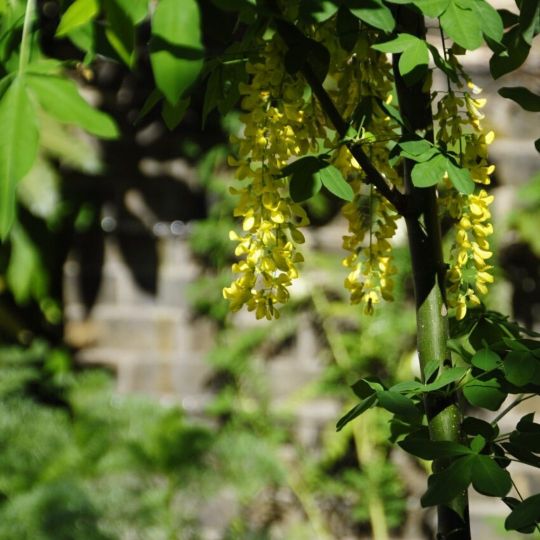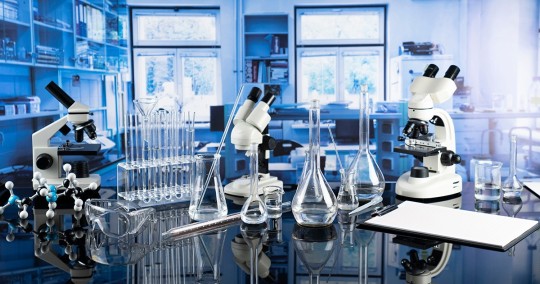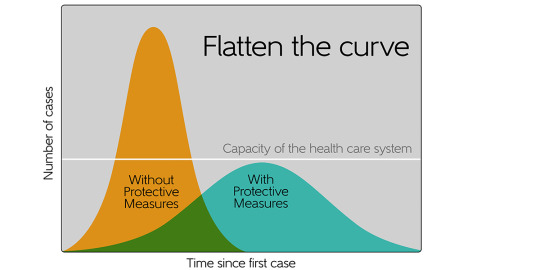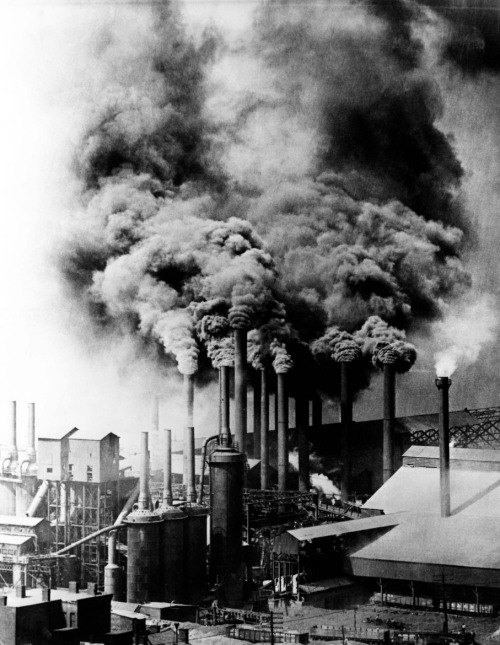#industry
Another month starts in the SCIence Garden with no visitors to appreciate the burgeoning growth of fresh new leaves and spring flowers, but that doesn’t mean we should forget about it!
Hopefully in our absence the Laburnum tree in the garden, Laburnumxwatereri‘Vossii’ will be flowering beautifully, its long racemes of golden yellow flowers looking stunning in the spring sunshine!

Laburnum x watereri ‘Vossii’ in the SCIence Garden
This particular cultivar originated in the late 19th century in the Netherlands, selected from the hybrid species which itself is a cross between Laburnum alpinum andL. anagyroides. This hybrid species was named for the Waterers nursery in Knaphill, Surrey and was formally named in a German publication of 1893 (Handbuch der Laubholzkunde, Berlin 3:673 (1893)

The laburnum tree is found very commonly in gardens in the UK, and is noticeable at this time of year for its long chains of golden yellow flowers. However, the beautiful flowers hide a dark side to this plant. The seeds (and indeed all parts) of the tree are poisonous to humans and many animals. They are poisonous due to the presence of a very toxic alkaloid called cytisine (not to be confused with cytosine, a component of DNA). Cytisine has a similar structure to nicotine (another plant natural product), and has similar pharmacological effects. It has been used as a smoking cessation therapy, as has varenicline, which has a structure based on that of cytisine. These molecules are partial agonists at the nicotinic receptor (compared to nicotine which is a full agonist) and reduce the cravings and “pleasurable” effects associated with nicotine.

Cytisine is found in several other plants in the legume family, including Thermopsis lanceolata, which also looks stunning in early summer and Baptisiaspecies, also growing in the SCIence Garden and flowering later in the year.

In 2018 there were 9.6 million deaths from cancer and 33% of these were linked to exposure to tobacco smoke.* Since the link between smoking and lung cancer was established in 1950, the market for smoking cessation therapies has increased enormously. In 2018 it was worth over 18 billion dollars annually worldwide and is projected to increase to 64 billion dollars by 2026.** Staggering! Varenicline, sold under the brand names Champix and Chantix, is one of the most significant smoking cessation therapies apart from nicotine replacement products.
If you see a laburnum tree whilst out on your daily allowed exercise this month, have a thought for its use as a smoking cessation therapy!
* Data from the Cancer Research UK website https://www.cancerresearchuk.org/health-professional/cancer-statistics/worldwide-cancer#heading-Zero accessed May 2020.
Written by Alison Foster: Botanical Horticulturist and Science Communicator
Here is a roundup on some of the most recent research and scientific efforts against the coronavirus.
Novartis:
Novartis has reached an agreement with the US Food and Drug Administration to proceed with a phase III clinical trial of hydroxychloroquine in hospitalized Covid-19 patients. The large trial will be conducted at more than a dozen sites in the US and tested on approximately 440 patients to evaluate the use for this treatment.
Additionally, Norvatis plans to make its hydroxychloroquine intellectual property available to support broad access to hydroxychloroquine. Read more here.

Causaly
Causaly, an innovative technology company that harnesses AI to interpret vast databases of biomedical knowledge, is collaborating with UCL academics to increase research on potential therapeutic agents and the identification of biomarkers.
Several researchers and research groups within UCL have been granted access to Causaly technology, allowing them the access to rapidly analyse and derive insights from biomedical literature.
Read more here.

Vaccine Taskforce
As part of the UK’s wider efforts to support the development of a vaccine, a new government-led Vaccine Taskforce will soon be launched to drive forward the manufacturing and research efforts to fight the virus.
The government will review regulations to facilitate fast and safe vaccine trials, as well as operational plans, to ensure a vaccine can be produced at a large scale when it becomes available. Industry and academic institutions will be given the resources and support needed.
Business Secretary Alok Sharma said, ‘UK scientists are working as fast as they can to find a vaccine that fights coronavirus, saving and protecting people’s lives. We stand firmly behind them in their efforts. The Vaccine Taskforce is key to coordinating efforts to rapidly accelerate the development and manufacture of a potential new vaccine.’ Read more here.

A new biosensor for the COVID-19 virus
Research teams at Empa and ETH Zurich have developed an alternative test method in the form of an optical biosensor. The sensor made up of gold nanostructure, known as gold nonoislands on a glass substrate, combines two different effects to detect covid-19: an optical and a thermal one.
According to the release, ‘Artificially produced DNA receptors that match specific RNA sequences of the SARS-CoV-2 [virus] are grafted onto the nanoislands,’ and researchers will then use the optical phenomena, - localised surface plasmon resonance - to monitor the presence of the virus.
The biosensor is not yet ready to be used to monitor and detect COVID-19, however tests showed the sensor can distinguish between very similar RNA sequences of SARS-CoV-2 virus and its relative, SARS-Cov. Read more here.
For more information and more updates on the coronavirus, please visit our hubhere.
As the COVID-19 outbreak increases pressure on the UK’s NHS services and frontline staff, leading scientists and businesses are taking on new initiatives to tackle the outbreak. As there is currently no treatment or vaccine for this virus, researchers are working at unprecedented speed to accelerate the development of a treatment. Businesses are putting in more effort to help those on the frontline of this global crisis.

Below, we have highlighted some of the actions from the chemical industry in the effort to battle COVID-19.
INEOS has managed to built a hand sanitzer plant in the UK and will soon open the facility in Germany, aiming to produce 1m bottles per month each to address a supply shortage across the UK and Europe.
BASF will soon be producing hand sanitizers at its petrochemicals hub in Germany to address the shortage in the region.
Ramping up the supply of PPE, AstraZeneca is donating nine million face masks to support healthcare workers around the world. Alongside this, AstraZeneca is accelerating the development of its diagnostic testing capabilities to scale-up screening and is also partnering with governments on existing screening programmes.
Pharmaceutical company Novartis UK, along with several others, is making available a set of compounds from its library that it considers are suitable for in vitro antiviral testing.
GSK has announced that is donating $10 million to the COVID-19 Solidarity Response Fund. The Fund was created by the World Health Organisation (WHO) to help WHO and its partners to prevent, detect and manage the pandemic

Alongside the efforts and initiatives from industries, to continue to aid those on the frontline of this global crisis, social distancing interventions must remain to flatten the curve.
Research and data modelling has shown that policy strategies, such as social distancing and isolation interventions which aim to suppress the rate of transmission, might reduce death and peak healthcare demand by two-thirds.

Stopping non-essential contact can flatten the curve. Suppressing the curve means we may still experience the same number of people becoming infected but over a longer period of time and at a slower rate, reducing the stress on our healthcare system.
Introduction
In November 2020, the UK is set to host the major UN Climate Change summit; COP26. This will be the most important climate summit since COP21 where the Paris Agreement was agreed. At this summit, countries, for the first time, can upgrade their emission targets through to 20301. In the UK, current legislation commits government to reduce greenhouse gas emissions by at least 100% of 1990 levels by 2050, under the Climate Change Act 2008 (2050 Target Amendment)2.
Hydrogen has been recognised as a low-carbon fuel which could be utilised in large-scale decarbonisation to reach ambitious emission targets. Upon combustion with air, hydrogen releases water and zero carbon dioxide unlike alternative heavy emitting fuels. The potential applications of hydrogen span across an array of heavy emitting sectors. The focus of this blog is to highlight some of these applications, and on-going initiatives, across the following three sectors: Industry, Transport and Domestic.
Please click (here3) to access our previous SCI Energy Group blog centred around UK CO2emissions.

Figure 1: climate change activists
Industry
Did you know that small-scale hydrogen boilers already exist?4
Through equipment modification, it is technically feasible to use clean hydrogen fuel across many industrial sectors such as: food and drink, chemical, paper and glass.
Whilst this conversion may incur significant costs and face technical challenges, it is thought that hydrogen-fuelled equipment such as furnaces, boilers, ovens and kilns may be commercially available from the mid-2020’s4.

Figure 2: gas hydrogen peroxide boiler line vector icon
Domestic
Did you know that using a gas hob can emit up to or greater than 71 kg of CO2per year?5
Hydrogen could be supplied fully or as a blend with natural gas to our homes in order to minimise greenhouse gas emissions associated with the combustion of natural gas.
As part of the HyDeploy initiative, Keele University, which has its own private gas network, have been receiving blended hydrogen as part of a trial study with no difference noticed compared to normal gas supply6.
Other initiatives such as Hydrogen 1007 and HyDeploy8are testing the feasibility of delivering 100% hydrogen to homes and commercial properties.

Figure 3: gas burners
Transport
Did you know that, based on an average driving distance of approximately 11,500 miles per annum, an average vehicle will emit approximately 4.6 tonnes of CO2per year?9
In the transport sector, hydrogen fuel can be utilised in fuel cells, which convert hydrogen and oxygen into water and electricity.
Hydrogen fuel cell vehicles are already commercially available in the UK. However, currently, form only a small percentage of Ultra Low Emission Vehicle (ULEV) uptake10.
Niche applications of hydrogen within the transport sector are expected to show greater potential for hydrogen such as buses and trains. Hydrogen powered buses are already operational in certain parts of the UK and hydrogen trains are predicted to run on British railways from as early as 202211.

Figure 4: h2 combustion engine for emission free ecofriendly transport
Summary
This blog gives only a brief introduction to the many applications of hydrogen and its decarbonisation potential. The purpose of which, is to highlight that hydrogen, amongst other low-carbon fuels and technologies, can play an important role in the UK’s transition to net-zero emissions.
Stay tuned for further SCI Energy Group blogs which will continue to highlight alternative low-carbon technologies and their potential to decarbonise.
Reace Edwards is a member of SCI’s Energy group and a PhD Chemical Engineering student at the University of Chester. Read more about her involvement with SCI here or watch her recent TEDx Talk here.
Links to References:
1. https://eciu.net/briefings/international-perspectives/cop-26
2. https://www.legislation.gov.uk/ukdsi/2019/9780111187654
3. https://sci.tumblr.com/post/186882462624/understanding-uk-carbon-dioxide-emissions
5. https://www.carbonfootprint.com/energyconsumption.html
6. https://hydeploy.co.uk/hydrogen/
7. https://sgn.co.uk/about-us/future-of-gas/hydrogen/hydrogen-100
9. https://www.epa.gov/greenvehicles/greenhouse-gas-emissions-typical-passenger-vehicle
https://www.telegraph.co.uk/cars/news/hydrogen-fuel-cell-trains-run-british-railways-2022/
NiKE AiR MAX PLUS and some industrial area
.
.
.
#nike #nikeaddict #nikeairmaxplus #nikeairmaxplus3 #coke #cokeplant #industry #industrial #steel #tubes #sneakers #sneakerhead #soletoday #instakicks #sneakerfiles #sneakgallery #kickstagram
https://www.instagram.com/p/B_j-_REK44z/?igshid=t4rktuhso1d1
Post link



Had the amazing opportunity to volunteer at @AnimexFestival this year. I spoke to @jasonwalden1971 and his beautiful @wacom setup at the event. In addition I had the awesome chance of meeting @bobby_br26354 from @insomniacgames and can I just say, you guys rock! Thanks to all!
“Head Office Blues”
Full-page illustration for CPA Magazine about the economic impacts of Head offices moving out of smaller cities.
Post link




Bethlehem Steel Blast Furnaces










Lukens Steel (Part 3)
Coatesville, Pennsylvania









Lukens Steel (Part 2)
Coatesville, Pennsylvania
# Madrid #industry (Madrid, Spain)
https://www.instagram.com/p/CMFr5oIA08a/?igshid=7kva6apv25bq
Post link
Cornucopianisme. Collage - 314
Vincent Cann production. My collection
Website : vincentcann.com
Follow me on Instagram&Facebook
Post link












